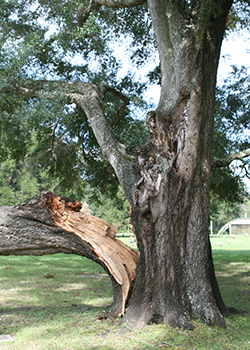Live Oak
The live oak is one of those plants that is inseparable from Florida’s identity.

Since live oaks live for hundreds of years, several generations get to enjoy each majestic, sprawling tree that is draped with moss. These trees provide many ecosystem services, and they are an excellent choice for homeowners who are searching for sturdy, wind-resistant trees.
Characteristics
Quercus virginiana is a massive oak tree that reaches 60-80 feet tall and up to 60-120 feet wide when grown under the right conditions. Although it can be trained to an upright growth habit, live oak will become multi-trunked with many winding branches if left alone. The bark starts out reddish-brown and lightly grooved when young, but mature trees have bark that is gray to nearly black, with deep furrows. When grown in the proper conditions, these trees can survive for centuries.
The evergreen leaves are oval and about two to five inches long. The tops are dark green and glossy, while underneath they are paler green and sometimes fuzzy. Flower spikes, called “catkins,” emerge in spring and are small and green. These insignificant flowers lead to acorns that are dark brown, oval-shaped, and three quarters of an inch long, with a bowl-shaped, scaly cap. Birds and other wildlife will flock to the tree for acorns.
Planting and Care

Live oaks can be planted in zones 7B through 10B. They are ideal shade trees, but make sure your planting location is large enough to accommodate its mature size. If planted too close to curbs, sidewalks, or driveways, the roots may eventually grow large enough to lift and crack surfaces. Choose a planting location that is in full sun to partial shade with moist, acidic soil of sand, loam, or clay. However, live oak can tolerate alkaline soils, salt, and drought. Make sure the tree has plenty of room to spread by not planting it near or under utility lines, light posts, etc.
Once you’ve planted your tree, establish a routine maintenance plan. You’ll need to reduce or remove multiple trunks that compete with the leader. Also, you should prune branches that form a narrow angle with the trunk because these are more likely to split from the tree as it ages. A dominant central leader will provide the tree with strong branch attachments and an overall durable structure that will help minimize wind damage. Prune your tree annually for the first five years, and then every three years until it reaches 30 years old.
Severe pest or disease problems are unlikely. Occasionally, you may find galls, scales, aphids, or boring insects. Young or weakened trees are more susceptible to pests. Oak wilt is a fatal disease that spreads from leaves into the heart of the tree, but so far it is primarily found in Texas. Diseases you may encounter include canker diseases, leaf spots caused by fungi, powdery mildew, and shoestring root rot. The best way to avoid disease is by providing a stress-free environment.

If you have any questions or concerns as you care for your live oak tree, contact the experts at your county Extension office.
